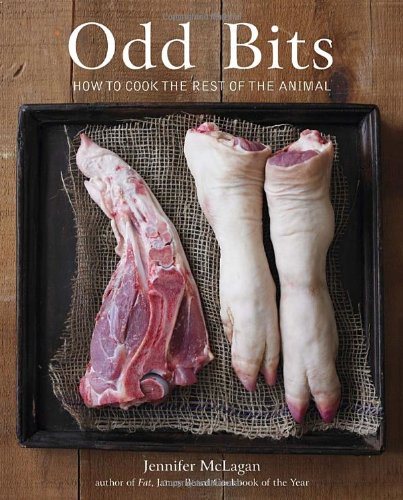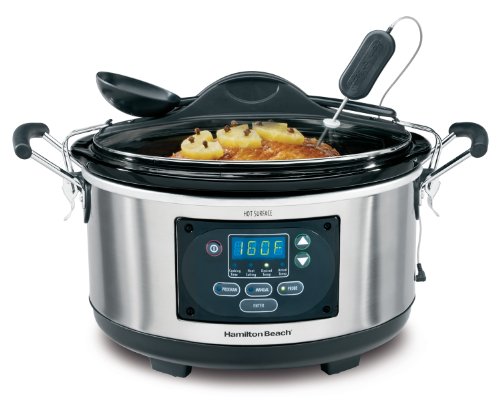Beef tongue. If you've ever had it, you love it. If you haven't, you are probably grossed out by the thought of preparing and eating it. After I bought my first beef tongue at the farmer's market a few years ago, it stayed in the freezer for a long time before I got the nerve to cook it. If you're like most people, it will take some mental preparation to get yourself psyched up to cook a tongue. But, it's actually extremely easy to cook, and will probably become one of your new favorites after you taste just how delicious and melt-in-your-mouth tender it is.
Why eat beef tongue? Like other organ meats, it is very nutrient dense. It is an excellent source of vitamin B12, and B12 deficiency may be much more prevalent than currently estimated. It's also a good source of B2, B3, and choline, and provides some B5 and B6. It is also an excellent source of zinc, and a good source of iron, phosphorus, and selenium (source). It is also an excellent source of collagen, with 14.6% of the total protein being collagen, which is good for your joints and skin. It's a very fatty cut, with about 70% of the calories coming from fat. This makes it a deeply satisfying, satiating, hearty meal. A little goes a long way.
First, I want to say that you should only buy tongue from a source you trust. For fatty meats, it's especially important to have a clean source. See if you can find a local farmer who raises grass-fed, hormone and antibiotic free cows. If you've got a Whole Foods, Earth Fare, or similar natural & organic grocery store, talk to the butcher and see if they can help you. You can also order online from places like Slanker's and U.S. Wellness Meats (affiliate link). Aim to get a tongue about 2-3 lbs in size. Or, get several and cook up a big batch to freeze, like I did here.
3 beef tongues, totaling about 6.5 lbs
It looks just like a giant tongue. Be prepared for that reality, and try not to focus on it too much before you get it in the cooking pot.
Take your thawed tongue and wash it. Wash it really well. You can even use a clean kitchen brush to scrub it. Just....try not to think too hard about what you're doing and you'll be fine. This is the only prep work you have to do.
I put 2 tongues in one pot, and 1 by itself in a smaller pot.
Put your squeaky clean tongue in a pot and cover with filtered water. There are lots of options for seasoning the water. Here, I kept it minimal with bay leaves and whole peppercorns. You can also add crushed garlic, sliced onion, or another herb like oregano. Part of why I kept it minimal is because I didn't have any room in my pot for anything else!
Cooked and ready to peel.
Put the lid on the pot, set to medium-low heat (or whatever setting on your stove will give you a gentle simmer), and walk away for a few hours. You can estimate about an hour per pound of tongue. You'll know it's ready when the skin turns white and you can easily pierce the meat with a knife.
Here's where it gets real. And a little tricky. You have to peel the skin off of the tongue and try not to burn your fingers in the process. The tricky thing is, if you let it cool off too much, then it gets really difficult to peel off the skin, especially from the underside of the tongue. I learned that the hard way when I followed one recipe's advice to dunk the tongue into an ice bath before peeling. Maybe the problem was that I just left it in the bath for too long, but I haven't tried again because it's kind of a hassle. And I've peeled plenty of tongues without the aid of an ice bath. I just set them out on a plate to cool off on their own.
I use a combination of a knife, fork, and my fingers to get the job done. Cut a small slit on the top side near the tip to start.
There's an second layer that's a little squishy underneath the skin that you may want to remove as well. I don't remove it unless it's just falling off on its own.
The skin on the top of the tongue should come off very easily. The skin on the underside will be a little more difficult, and you may have to use a knife to help.
Don't be intimidated by the underside of the tongue. I know it looks weird. It's all edible, don't worry. And it is going to be very tender and tasty, so you don't want to go crazy trimming just because it looks strange. I let my fingers guide my decisions for what to trim and what to leave. I only trim areas that feel slimy/gristly instead of meaty.
Save all your trimmings. Next time you make bone broth, you can add them to the pot.
Now that you've peeled your tongue, you have some options. Most websites will tell you that the next thing you do is slice and dice or pull and shred the meat, then fry up in a skillet to brown, and make tacos according to your taste. This is an excellent way to eat tongue. But I have another method that I prefer that involves the slow cooker.
Slice...
...and dice!
I find it easier to slice and then dice as opposed to pull tongue, and the end result is usually much more tender. First, cut thin slices against the grain. Then, dice into cubes.
Add the diced tongue to your slow cooker with some diced veggies and herbs. I like to use tomatoes, onion, garlic, green and red bell peppers, oregano, and cilantro. I like to spice it with paprika, cumin, salt, pepper, and maybe a little cayenne or other chili pepper. Add some of the cooking broth from your pot to the slow cooker, and freeze the leftover broth for use in another recipe. You don't want to add too much of the broth for two reasons: it's going to have a very strong flavor --- much stronger than typical bone broth. Also, a fair amount of water is going to cook out of all the veggies, and you don't want too much liquid in the final product.
In this particular instance, I was making such a big batch that I actually had to let my veggies cook down a bit on their own in the slow cooker to make room for the tongue! I let the veggies cook while the tongues were cooking.
Also, I cooked up so much tongue, that I had to freeze two pints of the plain diced meat. But, if you're making a more normal-sized batch from just one tongue, you'll be able to add all of the tongue to the raw veggies. Set on low and let it all simmer together for a while. An hour or two, whatever you like. The tongue will only get more tender and flavorful.
The end result will work well as a taco filling, like I did here (using yummy butter lettuce leaves as the "shell"). Or, you can use it as a topping for a salad or pair it with your favorite sauteed or steamed green. Tongue also goes well with something starchy like mashed sweet potato or potato, yuca, or white rice (if you tolerate it). Plátanos maduros (fried ripe sweet plantains) make an EXCELLENT side dish as well.
See? It's not so hard. And by the time you get to the final product, it is no longer recognizable as tongue. Just be brave during the initial cooking phase, and you will be rewarded in the end with one of the most succulent, juicy, tender, delicious (and very nutritious!) cuts of meat you have ever had.
Let me know what you think!
Looking for more recipes for offal and odd bits?
I've compiled over 100 recipes for nose-to-tail eating in a comprehensive Offal and Odd Bits post that includes everything from beef tongue, to classic liver and onions, how to make liver pills, many recipes with "hidden" offal (chilis, meatballs, hamburgers), and even more daring and exotic things like Rocky Mountain oysters, lamb's brains, and more! Plus, I've collected a wide range of desserts that use gelatin -- because that's part of nose-to-tail eating, too! I think you will enjoy it -- and please share any of your favorite recipes that you'd like to see me include! I am going to expand the post over time.
Book Recommendations
If you really want to get in-depth with learning more about all organ meats and how to utilize the whole animal, check out these books from my affiliate partner Amazon. Please note that in the cookbooks, you will have to make substitutions in some of the recipes if you adhere to a strict grain- or gluten-free, dairy-free, or legume-free diet. But, if you are following such a diet, you're probably pretty used to making those substitutions by now :) Also note that if you are from the US, the recipes may seem a bit foreign in Fergus Henderson's book, but it is still a lovely and inspirational volume regardless.
My Favorite Slow Cooker
The Hamilton Beach Set 'n Forget is my favorite slow cooker. I have had mine for over 3 and 1/2 years and I use it ALL the time. They have a more recent model that costs just a bit more and has modified handles, but my model has been so trusty and dependable that I prefer to recommend it to people instead of the new version.
The best part about this slow cooker is that you can program it to cook for however many hours you want, and after that point it automatically switches to "warm" to keep your food hot, but not overcooked, for you when you get home from a long day at work. It also has a meat thermometer you can attach to it and you can actaully program it to switch to "warm" after it reaches a set temperature. You can purchase the slow cooker from my affiliate partner Amazon.










